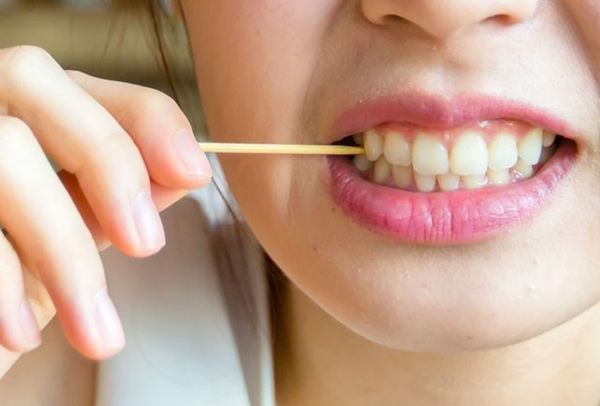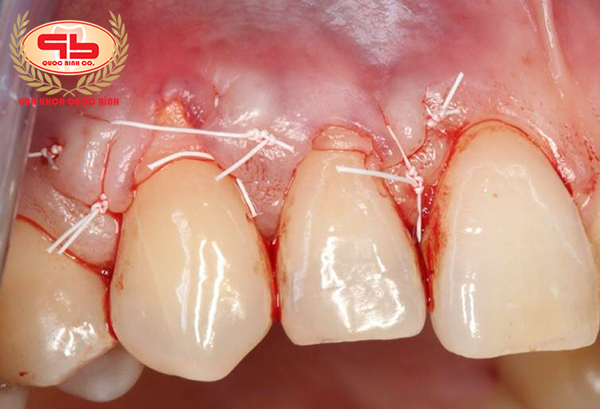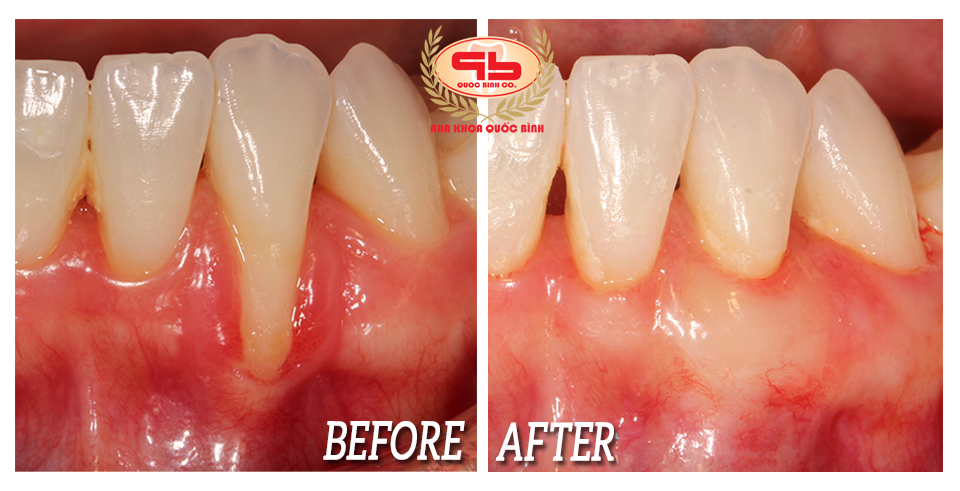When the gums recede from their normal position, and exposing a part of the tooth’s neck. This will cause sensitivity when eating hot and cold food. They are called the gums recession to expose the tooth’s neck. This condition will make your teeth look longer and lose your aesthetic. And at present, gingival graft surgery is a pretty effective solution to treat this condition.
What are the causes of gums recession?
There are several causes of gums recession:
@ When receding gums due to gingivitis, inflammation around the teeth is often accompanied by bleeding and swelling of the gums. Gums can be receded in some tooth, or all of the teeth.
The most common cause of gingivitis is when the tartar accumulates in the root of the tooth but is not treated thoroughly.
@ Gums recession not due to gingivitis. Because the bone layer covers the outer surface of the tooth root is too thin, prone to trauma leading to receding gums.
In addition, for patients with misleading bite joints, there is often more traumatized. And this will aggravate the gums recession. You can see, the teeth are deflected out of the jaw is also easy to encounter this situation.
Gums recession is also detected after orthodontic treatment.
@ Gums recession due to mechanical impact. This is quite a common cause in older people. Because of the habit of using a hard bristle brush and brushing teeth incorrectly. In addition, receding gums is due to the use of toothpicks.
Gingivitis due to mechanical effects is common in the canines, incisors, rarely seen in the molars.

When there is a gums recession to expose the tooth’s neck, the gingival graft treatment will help you recover from this condition.
- Gingival graft surgery not only helps the teeth no longer be sensitive, but it also regains the beauty of the teeth.
- In addition, gingival graft also help prevent some other diseases such as damage to gum tissue, bone destruction.

Treatment process with gingival graft surgery
Step 1: Check-up
Examination of the oral cavity and condition of gums recession to expose the tooth’s neck
Take x-ray to examines the jaw bone thickness, how much the gums recession.
Step 2: get a doctor’ advice
The specialist will advise you on gingival graft surgery methods. The principle of these surgeries is to use the mucous flap in the adjacent tooth area. Can be used with implant material to cover the root area of the gums recession.
Typically gingival graft from your own mucous region. Biological tissue transplantation from animals or from others.
Note: The choice of gingival graft and grafting material methods depends on
- The actual level of gums recession (heavy or light).
- The number of teeth with receding gums (single tooth or multiple teeth in a row),
- The area that needs gingival graft (incisors or molars)
- Anatomical structure of the adjacent area (thick or thin adhesion organization).
Step 3: Cleaning the oral cavity and local anesthesia
To ensure gingival graft surgery is performed in a sterile, safe, and comfortable environment.
Step 4: Perform surgery
Step 5: Instructions on how to care for and schedule a follow-up appointment
Attention in care after performing gingival graft surgery
- Avoid eating foods that are too hard because they can peel grafted gums. Should eat soft food in the first week after gingival graft surgery.
- Do not brush your teeth into the gingival graft area for the first 2 weeks. You can clean your teeth and surgery area with a cotton swab with diluted betadine solution; Or with physiological saline spray wash through the syringe.
- From the second week, brush your teeth gently with a very soft bristle brush.
- Adhere to the schedule of antibiotics, pain relief, anti-edema in 1 week as directed by the doctor.
- Follow the regular follow-up schedule to check the surgical area.
Preventing gums recession to expose the tooth’s neck
- Need to use a soft bristle brush to clean your mouth.
- Brush your teeth properly (vertical brushing and turning)
- Using an antibacterial mouthwash, supplementing with fluoride to increase the cleansing and strengthening effect of tooth enamel.
- It is recommended to go to the dentist every 6 months to clean the tartar and promptly detect gingivitis and inflammation around the teeth. In particular, for those who are at high risk of receding gums such as thin gum structure, deviant teeth, or have a low lip brakes…
- Should be examined to be consulted by dentists to prevent disease.
Any question please contact
QUOC BINH DENTAL CLINIC IN VUNG TAU CITY
19 Pham Hong Thai, Ward 7, Vung Tau City.
28 Le Loi, Ward 4, Vung Tau City.
Hotline for booking appointment: 0914 83 99 66
Online information page:
Link 1 (general): https://www.facebook.com/nhakhoaquocbinh/
Link 2 (aesthetic): https://www.facebook.com/nhakhoathammyvungtau/

